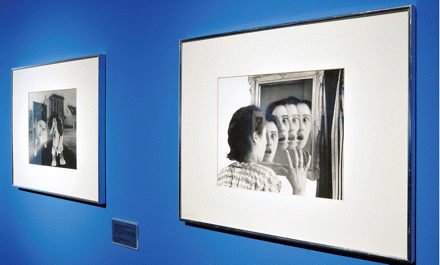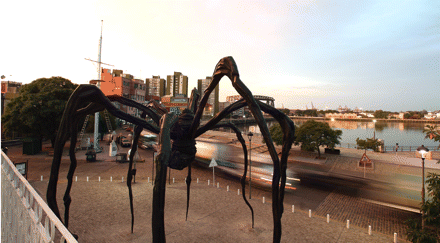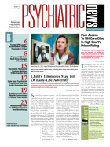The Museum of Art of Latin America in Buenos Aires, the MALBA, recently mounted an exhibit of photo montages from a series titled "Los Sueños" (The Dreams). These surreal images accompanied a weekly column, "Psychoanalysis Will Help You," published in a popular women's magazine, Idilio (Idyll), from 1948 to 1951.
Photojournalist Grete Stern created the montages to illustrate dream reports Idilio readers submitted for discussion in the column.
The magazine Idilio sought a wide female audience. Along with articles on housekeeping and fashion, its first issue included a report on "the mysterious world of dreams." The magazine invited readers to answer a psychological questionnaire and send dream reports for a column aimed at helping them better understand emotions and manage conflicts.
Sociologist Gino Germani, then a professor of sociology at the University of Buenos Aires, and later a professor of Latin American Studies at Harvard, wrote the column under the pen name Richard Rest. Germani and Stern reviewed dream narratives before Stern produced her photo montages.
The works in the MALBA show were printed from 46 surviving negatives of photos Stern took of the 150 montages she made for the column's three-year run. The exhibit did not include Germani's commentaries.
Youthful, attractive, and often well-dressed, the female characters in Stern's images portray idealized Idilio readers. Their dreams, however, reveal difficult relationships with husbands and lovers and stifled ambitions for independence and self-fulfillment.
In "Café Concert," a woman in an evening gown plays a piano before an attentive audience; her keyboard is that of a secretary's typewriter. Another woman bangs on a massive closed door, its handle far above her head.
Many images depict Herculean tasks. A woman in a skirt and high heels attempts to scale the face of a cliff encrusted with sharp shell fragments that offer no purchase for hands or feet. Raging waves below threaten to wash her away.
Animals sometimes stand in for men. A woman inside a glass house watches a lion pounce on her doorstep. Another shrinks in horror as an approaching commuter train morphs into a sea monster. In "Love Without Illusion," a woman's male companion has the head of a turtle.
Some women appear passively to accept their fate. One pulls a net over herself, as a man dangles it from a window. Another has been transformed into a statuette at the base of a lamp on which a man presses the on/off switch. One woman sits in a bottle at the edge of the sea. Who will set her adrift? Who will find the bottle? What message will she convey?
Stern's photomontages were "the first—and most important—photography work radically critical of the oppression and manipulation endured by women in Argentine society of that time, and of the humiliating consequence of consented-to submissiveness," historian Luis Priamo wrote in a catalog accompanying an earlier exhibition of this work.
Born in Germany, Stern studied photography at the Bauhaus School. After Hitler became German chancellor in 1933, she fled to England with her future husband, Argentine photographer Horacio Coppola. They moved to Argentina in 1935 where they mounted what was called the nation's first modern photography exhibit. Stern died in 1999 at age 95.
In another exhibit, Buenos Aires' Foundation PROA presented "The Return of the Repressed," a retrospective of sculptures, installations, and other works that Franco-American artist Louise Bourgeois produced from 1947 to 2009. Bourgeois died last year at age 98.
This exhibition brought the artist's work to Argentina for the first time. One of Bourgeois' monumental spider mothers, a 30-foot tall bronze spider, "Maman," stands at the entrance to the Bourgeois exhibit.
A second massive mother spider lurks in the exhibit's dimly lit first room. Daunting, yet protective, it hovers over a circular cage that encloses an armchair draped in a well-worn tapestry. The spider, Bourgeois said, is an ode to her own mother, a weaver.
The 86 Bourgeois works at the PROA included two large installations. In "Red Room" a double bed with a bedspread remains largely hidden behind doors. To see the room's interior, visitors must peer through small openings or look at reflections in a mirror. The scene evokes childhood fantasies and fears about parental sexual behavior.
"The Destruction of the Father" is a dark cave-like chamber, bathed in red light. It contains a dining table topped with dark, vaguely anatomical forms that appear to be remnants of a meal. This work, Bourgeois wrote, enacts a childhood fantasy of dismembering and devouring her domineering father.
The death of Bourgeois' father in 1951 prompted her to enter psychoanalysis, according to exhibit curator Philip Larratt-Smith. Bourgeois saw New York analyst Henry Lowenfeld, M.D., regularly from 1952 to 1966 and then intermittently over the next two decades. One of her sculptures, "Rondeau for L," testifies to Lowenfeld's enduring presence in her life.
More than 1,000 pages of Bourgeois' unpublished writings turned up in the past decade during renovation of her long-time Manhattan home.
These writings will enrich both psychoanalytic and art history, Mignon Nixon, Ph.D., a professor of art history at the Courtauld Institute of Art at the University of London, asserted in the exhibit catalog. Bourgeois' writings, Nixon said, explore "dreams, symptoms, memories, fantasies, anxieties, desires, and complaints, interleaved with drawings, notes from her reading, postsession reflections, and occasional nuggets of analytic wisdom."
In an essay on Bourgeois and Lowenfeld, Donald Kuspit, Ph.D., a professor of art history and philosophy at the State University of New York at Stony Brook, called Bourgeois "the premier psychoanalytically oriented artist of modernity."


